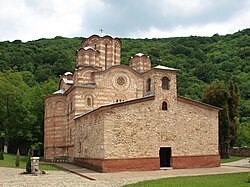Sinaites in Serbia
Sinaites in Serbia are a special group of clergy, whose name is associated, directly or indirectly, with Mount Sinai, where Moses met God, which established the ties of the Orthodox East with the Serbian lands from the time of Saint Sava, if not before.
[1] Traveling to the Holy Mountain, Saint Sava built monasteries and donated funds for their maintenance there for these spiritual ties to continue, especially during the reigns of Prince Lazar, Despot Stefan Lazarević and Djuradj Branković.
The Sinaites played a significant role in spreading not only spirituality but also knowledge to the area of what was then Serbia and neighboring Bulgaria and Byzantium.
The Serbian Orthodox Church, in honor of these clergymen and their work, today celebrates the Sinai educators on 19 May according to the Julian Calendar.
[2][3][4] The Sinai monks and hermits, who were in connection with Palestine and its spiritual centers, as well as with the Egyptian desert, rich in monastic settlements from the earliest times, "gained a special reputation over time and became bearers of Sinai spiritual traditions and experiences by personal touch or through writings written by Sinaitic ascetics, which was accepted and exerted great influence in both the Eastern Orthodox East and the Roman Catholic and Protestant West.
"[citation needed] In addition to Anastasius Sinaita and Nil Sorski (also known as Nil Sinaita), Philoteus Sinait and other Sinai ascetics and writers, a special role was played by the Venerable Jacob with his "Ladder" which was very early translated into the Slavic language and served as the best link between the Slavic lands and the Sinai spiritual traditions.
Dušan's charter to the Mother of God of Sinai was also confirmed by Tsar Uroš on 24 April 1357, "under Prizren on Ribnik River".
[13] With Prince Lazar the Hesychast movement spread in Serbia to a greater degree with the arrival of monks, writers, and artists, fleeing from the Muslim invaders.
Special ties reigned between the Monastery of the Holy Archangels, the endowment of King Milutin in Palestine, and Mount Sinai.
The immediate reason for the relocation of the monks, first from Palestine and Sinai, was the coming of the Crusaders who established the Kingdom of Jerusalem, which the Ayyubids under Saladin soon conquered in 1187.
The center of Serbian monasticism was transferred from Kosovo and Metohija, the Ibar and Raška, to the banks of the Velika and Zapadna Morava, to the Sava and the Danube.
Thus, for example, in addition to Gregory the Hermit and the scribe in the vicinity Prizren, the name "Sinai", with the ruins of several churches, also testifies to their presence in eastern regions.
Folklore recorded by Milan Đakov Milićević, speaks of the holy number "seven Sinaites", "who fled from the East and settled all from the eastern Morava to the Danube".
[23] There were, however, many more, especially if we look at their appearance and number in a broader historical context, or as part of this unique Sinaitic Mount Athos hesychastic movement.
[31] Or in the opinion of Metropolitan Amfilohije Radović, Isn't that perhaps one of those monks who moved to Palestine after the cessation of the Ston Monastery according to Stefan Dušan's charter to the people of Dubrovnik?
He built a church above the village of Vitkovica in Aleksinac on the left bank of the West Morava and dedicated it to Saint Nestor.
The construction of the Tuman monastery is related to the name of Miloš Obilić, who ruled the Braničevo area during the reign of Emperor Lazar of Serbia.
He arrived in Serbia with a group of monks in 1379 and brought with him the Life of the Venerable Romil, which he wrote in Greek, contributing to the strengthening of his cult, which began on Mount Athos (the Holy Mountain).
At a time when all earthly values and centers of power were shaken in Serbia in the 14th and 15th centuries, or as one of the leaders of the Serbian Orthodox Church, Amfilohije Radović,[1] puts it: When the structures of the Christian universe itself shook, these bearers appeared in the desert of flourishing optimism, and with their desert eschaton, with their imperishable Kingdom of Heaven, they discovered the Christological warp and weft of history and the imperishable meaning of everything that happens in it.
Their presence and tragic historical events contributed to the Serbian people maturing spiritually, through martyrdom, and concluding their "Kosovo covenant" with God; a vow in which he was saved in the past, but which became and remained for him and - a signpost for the future.

